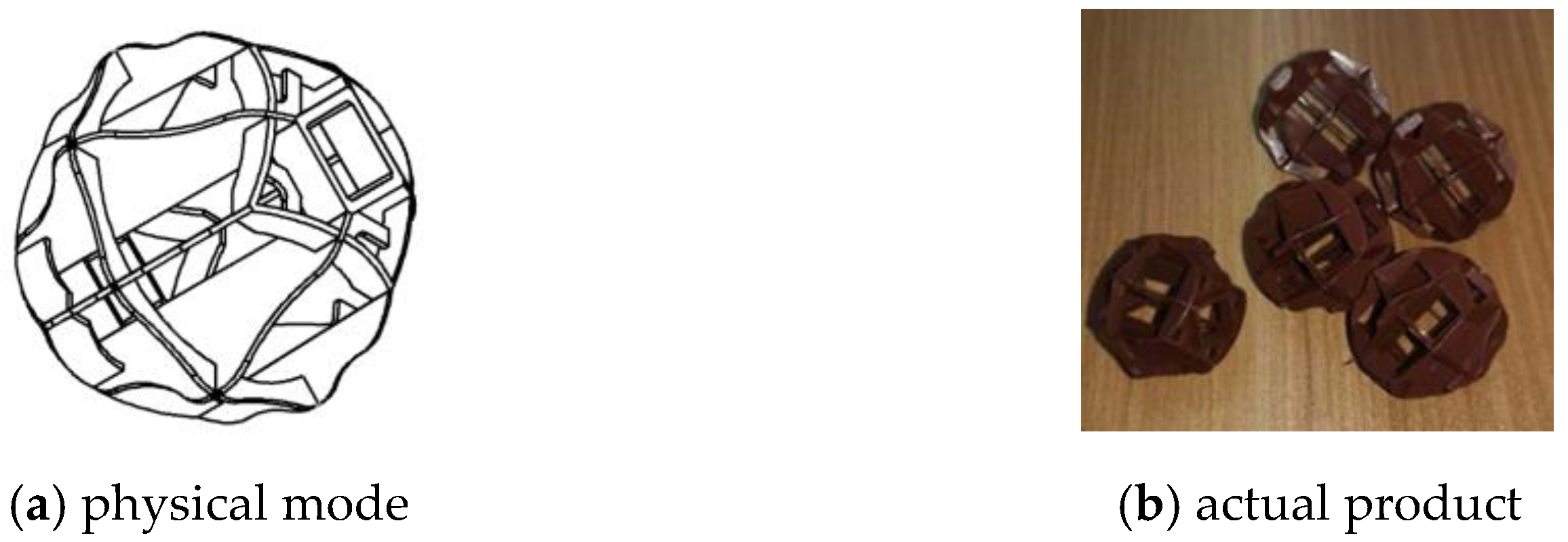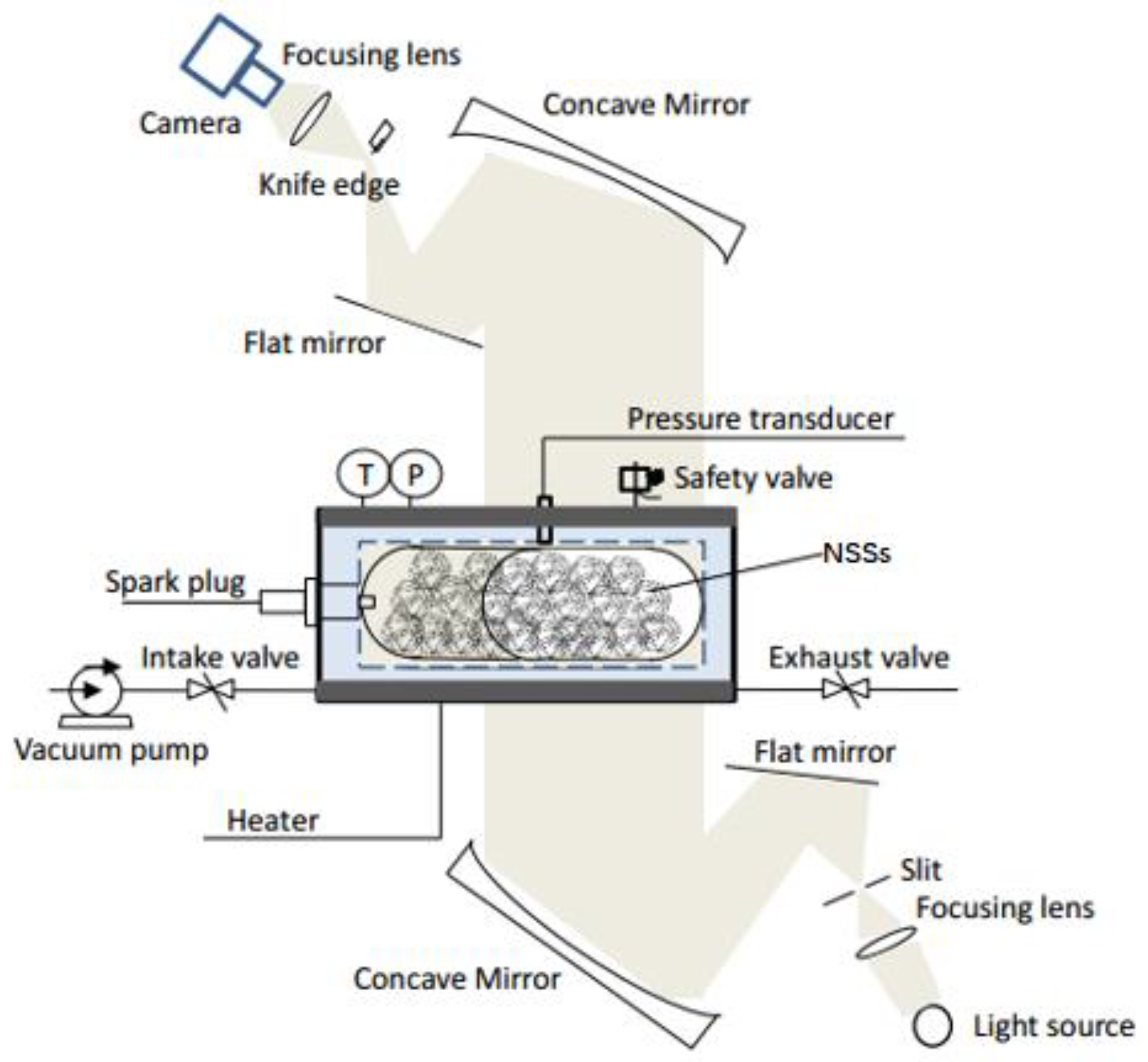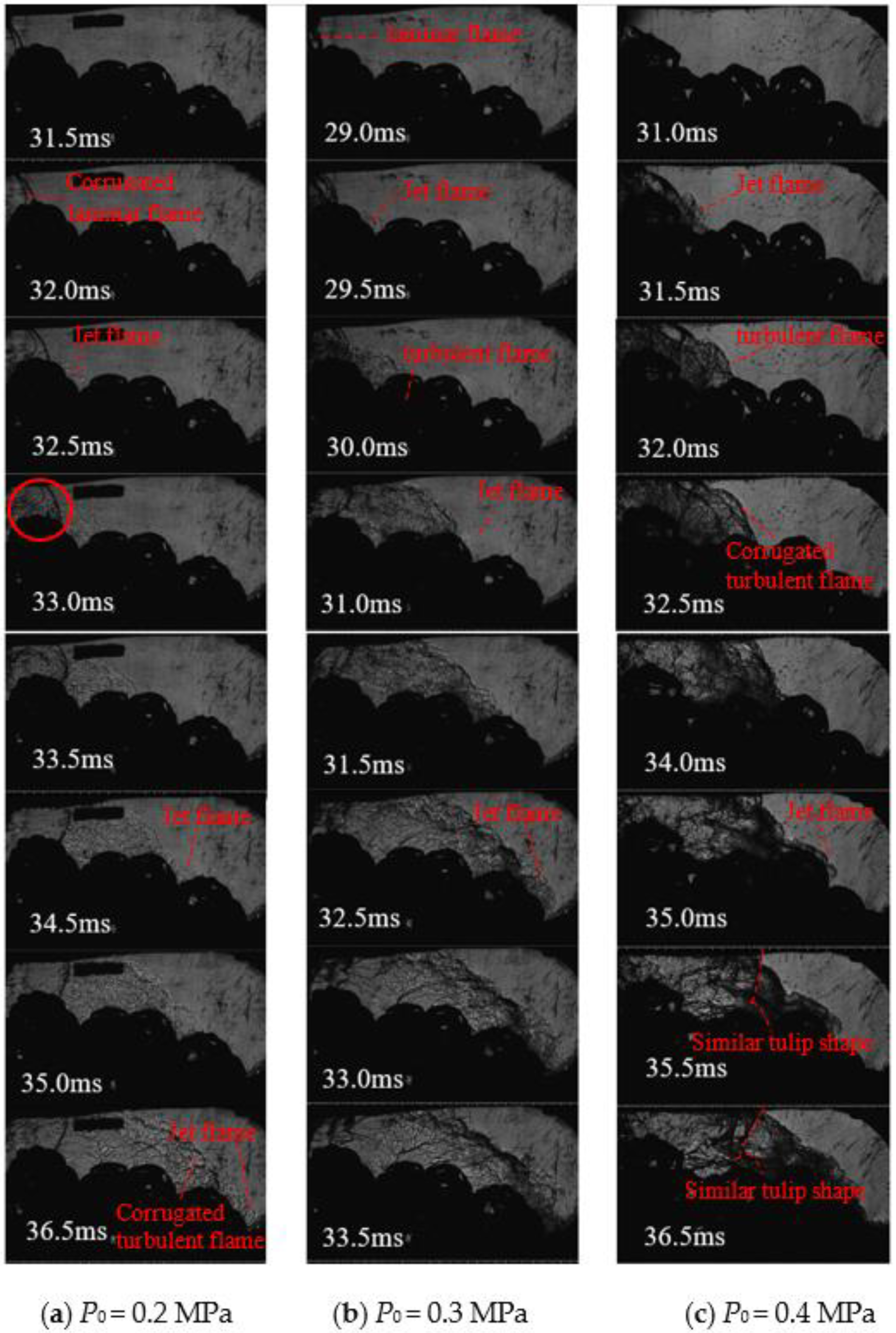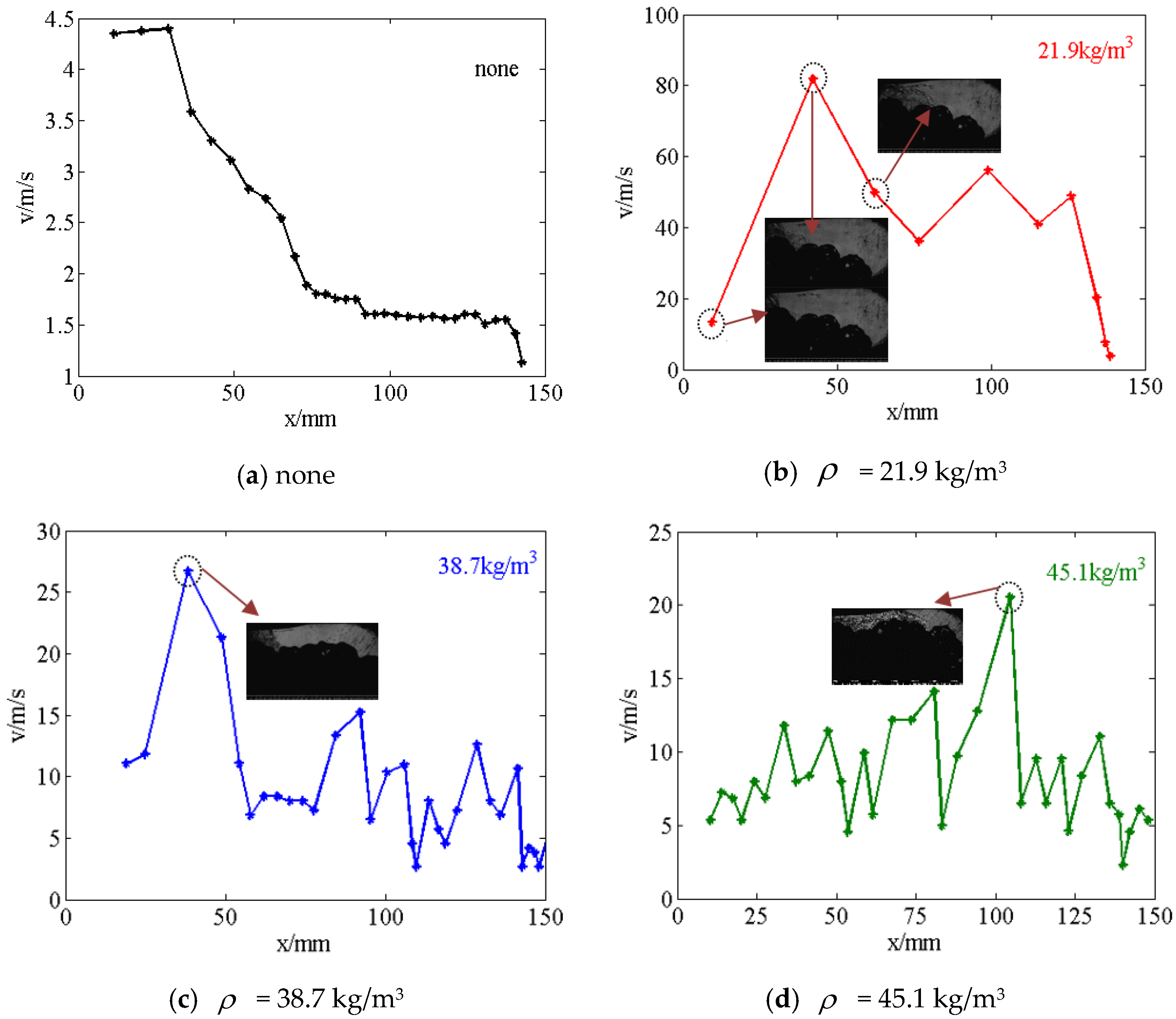Explosion-Suppression Characteristics of Nonmetallic Spherical Spacers on Propane-Air Mixtures in Confined Space
Abstract
:Featured Application
Abstract
1. Introduction
2. Experimental Setup
2.1. Nonmetallic Spherical Spacer
2.2. Experimental Apparatus
2.3. Experimental Parameters and Procedures
3. Results and Discussion
3.1. Variation of Pressures under the Influence of NSSs
3.2. Effect of NSSs on Explosion Flame Propagation
3.3. Effect of Initial Pressure on Flame Tip Velocity
3.4. Effect of Filling Density on Flame Tip Velocity
4. Conclusions
- (1)
- It was found that NSSs promoted pressure rise in the initial propane–air premixed combustion and inhibited the pressure rise in the later reaction period. Thus, the result of overpressure decreased in confined space due to heat loss was caused by huge amounts of NSSs. NSSs also suppress propane from cracking into more radicals and thus led to a higher amount of residual propane. Thus, it was explained that the explosion-suppression effects of NSSs on pressures and the explosion suppression mechanism of NSSs. Under different initial pressures (0.2 MPa, 0.3 MPa and 0.4 MPa), with the increase of filling density, the overpressure decreased, the time to reach explosion overpressure decreased and the decay rate of explosion overpressure Rpmax increased. For this experimental environment, NSSs had the best explosion suppression effect when the filling density was 45.1 kg/m3 under different initial pressures.
- (2)
- Under different initial pressures, flame passed through NSSs, the flame expanded and accelerated, and the NSSs acted as obstacles. When the filling density of NSSs was 21.9 kg/m3, the unfilled area was large. Further, the flame passed through the NSSs, which formed a vortex. The breakage of the vortex and the stretching of the flame array made the flame accelerate faster. When the filling densities of the NSSs were 38.7 kg/m3 and 45.1 kg/m3, the unfilled area was small, so that most of the flame exists in the rear of the NSSs, leading to the decrease of the flame velocity, and the oscillation degree of the flame tip velocities decreased. This was positively correlated with the increase of the decay rate of explosion overpressures. It was verified that NSSs promoted effect on flame velocity and suppressed effect of filling density on flame velocity.
- (3)
- On one hand, NSSs suppressed the explosion overpressure in the cylinder, the higher density of NSSs was, the stronger their suppression effect was; however, on the other hand, NSSs promoted the flame propagation. In both cases, the NSSs played a dual role on explosion suppression or promotion. However, it is important to illustrated that its double role can also be available for the experimental set-u, similar to equipment used in this investigation.
- (4)
- NSSs are also usually filled in gas storage with two perforated plates to prevent flammable gas explosion. The flame passes through the perforated plates, and accelerates, thus different combustion models including local autoignition and end gas autoignition will be induced by compression effect. As a result, the explosion-suppression mechanism of NSSs at the condition of flame acceleration in confined spaces with perforated plates can be further investigated in detail. The explosion-suppression effects of NSSs on different combustion models should be further investigated in depth to prevent flammable gas explosion under different combustion environments or intensive combustion environments.
Author Contributions
Funding
Acknowledgments
Conflicts of Interest
References
- Meng, X.; Tian, H.; Zhou, Y.; Tian, J.; Long, W.; Bi, M. Comparative study of pilot fuel property and intake air boost on combustion and performance in the CNG dual-fuel engine. Fuel 2019, 253, 116003. [Google Scholar] [CrossRef]
- Meng, X.; Tian, H.; Long, W.; Zhou, Y.; Bi, M.; Tian, J.; Lee, C.F. Experimental study of using additive in the pilot fuel on the performance and emission trade-offs in the diesel/CNG (methane emulated) dual-fuel combustion mode. Appl. Therm. Eng. 2019, 157, 113718. [Google Scholar] [CrossRef]
- Meng, X.; Zhou, Y.; Yang, T.; Long, W.; Bi, M.; Tian, J.; Lee, C.F. An experimental investigation of a dual-fuel engine by using bio-fuel as the additive. Renew. Energy 2020, 147, 2238–2249. [Google Scholar] [CrossRef]
- Di Sarli, V.; Di Benedetto, A.; Russo, G. Sub-grid scale combustion models for large eddy simulation of unsteady premixed flame propagation around obstacles. J. Hazard. Mater. 2010, 180, 71–78. [Google Scholar] [CrossRef]
- Di Sarli, V.; Di Benedetto, A.; Russo, G. Large Eddy Simulation of transient premixed flame–vortex interactions in gas explosions. Chem. Eng. Sci. 2012, 71, 539–551. [Google Scholar] [CrossRef]
- Zhou, S.Y.; Gao, J.C.; Hu, S.T. Study of the effect of metal filamentary material on premixed gas explosion. J. Beijing Inst. Petrochem. Technol. 2019, 27, 62–66. [Google Scholar]
- Hu, S.T.; Zhou, S.Y.; Gao, J.C. The research on explosion suppression effect of aluminum alloy explosion-proof materials cleaned by ultrasonic. Saf. Eng. Ser. 2019, 6, 14–20. [Google Scholar]
- Chen, P.; Huang, F.J.; Sun, Y.D.; Chen, X.X. Effects of metal foam meshes on premixed methane-air flame propagation in the closed duct. J. Loss Prev. Process. Ind. 2017, 47, 22–28. [Google Scholar] [CrossRef]
- Cui, Y.Y.; Wang, Z.R.; Zhou, K.B.; Ma, L.S.; Liu, M.H.; Jiang, J.C. Effect of wire mesh on double-suppression of CH 4/air mixture explosions in a spherical vessel connected to pipelines. J. Loss Prev. Process. Ind. 2017, 45, 69–77. [Google Scholar] [CrossRef]
- Liu, R.; Wang, L.Q.; Pan, J. The influence of a crimped-ribbon plate on gaseous explosion characteristics in a closed vessel. Int. J. Hydrogen Energy 2020, 45, 11866–11874. [Google Scholar] [CrossRef]
- Bivol, G.Y.; Golovastov, S.V.; Golub, V.V. Attenuation and recovery of detonation wave after passing through acous-tically absorbing section in hydrogen-air mixture at atmospheric pressure. J. Loss Prev. Process. Ind. 2016, 43, 311–314. [Google Scholar] [CrossRef]
- Shao, J.W.; Zhuang, C.J.; Wang, Z.R. Explosion suppression effect of CH4/air by combined porous materials in a container piping system. Explos. Shock Waves 2018, 38, 905–912. [Google Scholar]
- Nie, B.S.; He, X.Q.; Zhang, R.M.; Chen, W.X.; Zhang, J.F. The roles of foam ceramics in suppression of gas explosion overpressure and quenching of flame propagation. J. Hazard. Mater. 2011, 192, 741–747. [Google Scholar] [CrossRef] [PubMed]
- Song, X.Z.; Zuo, X.C.; Yang, Z.K.; Chen, J.; Xie, L.F.; Li, B. The explosion-suppression performance of mesh aluminum alloys and spherical nonmetallic materials on hydrogen-air mixtures. Int. J. Hydrogen Energy 2020, 45, 32686–32701. [Google Scholar] [CrossRef]
- Lei, Z.; Xie, L.; Lu, C.; Han, Z.; Wang, D.; Wang, H. Experimental study and comparative analysis on the explosion sup-pression performance of metallic and nonmetallic explosion suppression materials. Petrochem. Saf. Env. Prot. Technol. 2014, 30, 37–41. [Google Scholar]
- Joo, H.; Duncan, K.; Ciccarelli, G. Flame-quenching performance of ceramic foam. Combust. Sci. Technol. 2006, 178, 1755–1769. [Google Scholar] [CrossRef]
- Lu, C.B.; Zhu, X.D.; Wang, H.Z. Comprehensive evaluation on explosion proof performance of non-metallic barrier and explosion proof material. J. Saf. Sci. Technol. 2014, 10, 125–130. [Google Scholar]
- Zhao, Y.D.; Jiang, X.S.; Xie, W.; He, D.H. Experimental study on suppression of gasoline-air mixture explosion in nar-row-confined space using non-metallic spherical anti-explosion material. Contemp. Chem. Ind. 2020, 49, 1017–1022. [Google Scholar]
- Ibrahim, S.; Hargrave, G.; Williams, T. Experimental investigation of flame/solid interactions in turbulent premixed combustion. Exp. Therm. Fluid Sci. 2001, 24, 99–106. [Google Scholar] [CrossRef]
- Park, D.; Lee, Y.; Green, A. Prediction for vented explosions in chambers with multiple obstacles. J. Hazard. Mater. 2008, 155, 183–192. [Google Scholar] [CrossRef] [PubMed]
- Ciccarelli, G.; Johansen, C.; Parravani, M. The role of shock-flame interactions on flame acceleration in an obstacle laden channel. Combust. Flame 2010, 157, 2125–2136. [Google Scholar] [CrossRef]
- Gubba, S.; Ibrahim, S.; Malalasekera, W.; Masri, A. Measurements and LES calculations of turbulent premixed flame propagation past repeated obstacles. Combust. Flame 2011, 158, 2465–2481. [Google Scholar] [CrossRef] [Green Version]
- Wen, X.; Yu, M.; Liu, Z.; Sun, W. Large eddy simulation of methane-air deflagration in an obstructed chamber using different combustion models. J. Loss Prev. Process. Ind. 2012, 25, 730–738. [Google Scholar] [CrossRef]
- Wen, X.; Xie, M.; Yu, M.; Li, G.; Ji, W. Porous media quenching behaviors of gas deflagration in the presence of obstacles. Exp. Therm. Fluid Sci. 2013, 50, 37–44. [Google Scholar] [CrossRef]
- Bychkov, V.; Akkerman, V.; Fru, G.; Petchenko, A.; Eriksson, L.E. Flame acceleration in the early stages of burning in tubes. Combust. Flame 2007, 150, 263–276. [Google Scholar] [CrossRef]
- Bychkov, V.; Valiev, D.; Eriksson, L.E. Physical mechanism of ultrafast flame acceleration. Phys. Rev. Lett. 2008, 101, 164501. [Google Scholar] [CrossRef]
- Ciccarelli, G.; Fowler CJBardon, M. Effect of obstacle size and spacing on the initial stage of flame acceleration in a rough tube. Shock Waves 2005, 14, 161–166. [Google Scholar] [CrossRef]
- Ciccarelli, G. Explosion propagation in inert porous media, Philosophical Transactions of the Royal Society A: Mathematical. Phys. Eng. Sci. 2012, 370, 647–667. [Google Scholar]
- Liu, Y.L.; Zheng, J.Y.; Xu, P. Numerical simulation on the influence of environment temperature on the leakage and diffusion of high pressured hydrogen due to storage tank failure. J. Eng. Phys. 2008, 29, 770–772. [Google Scholar]
- Li, W.; Zhang, Q. Numerical Simulation of Leakage Injection and Diffusion of High Pressure Gases; China Occupational Safety and Health Association: Haikou, China, 2008; Volume 7, pp. 319–325. [Google Scholar]
- Zhou, C.B.; Mu, X.G.; Zhang, Y.Z.; Wang, X.J. Review on the research methods of the barrier and explosion-proof properties of porous materials. AIP Conf. Proc. 2018, 1995, 1–9. [Google Scholar]
- Tang, C.L.; Huang, Z.H.; Jin, C.; He, J.J.; Wang, J.H.; Wang, X.B.; Miao, H.Y. Explosion characteristics of hydro-gen-nitrogen-air mixtures at elevated pressures and temperatures. Int. J. Hydrogen Energ. 2008, 34, 554–561. [Google Scholar] [CrossRef]
- Sun, Z.Y. Explosion pressure measurement of 50% H2-50% CO synthesis gas—Air mixtures in various turbulent ambience. Combust. Sci. Technol. 2018, 190, 1007–1022. [Google Scholar] [CrossRef]
- Fothergill, C.E.; Chynoweth, S.; Roberts, P.; Packwood, A. Evaluation of a CFD porous model for calculating ventilation in explosion hazard assessments. J. Loss Prev. Process. Ind. 2003, 16, 341–347. [Google Scholar] [CrossRef]
- Birk, A.M. Review of expanded aluminum products for explosion suppression in-containers holding flammable liquids and gases. J. Loss Prev. Process. Ind. 2008, 21, 493–505. [Google Scholar] [CrossRef]
- Lv, X.S.; Zheng, L.G.; Zhang, Y.G.; Yu, M.G.; Su, Y. Combined effects of obstacle position and equivalence ratio on over-pressure of premixed hydrogen-air explosion. Int. J. Hydrogen Energy 2016, 41, 17740–17749. [Google Scholar] [CrossRef]
- Wang, L.Q.; Ma, H.H.; Shen, Z.W.; Chen, D.G. The influence of an orifice plate on the explosion characteristics of hy-drogen-methane-air mixtures in a closed vessel. Fuel 2019, 256, 1–6. [Google Scholar] [CrossRef]
- Zhuang, C.J.; Wang, Z.R.; Zhang, K.; Lu, Y.W.; Shao, J.W.; Zhan, D. Explosion suppression of porous materials in a pipe-connected spherical vessel. J. Loss Prev. Process. Ind. 2020, 65, 104106. [Google Scholar] [CrossRef]
- Liu, L.H.; Bi, F.R.; Yu, Y.Y. Influence of packed densities of nonmetallic spherical spacers on propane explosion suppression. Chin. J. Energetic Mater. 2021, 2021, 1–9. [Google Scholar]
- Zhou, L.; Zhong, L.; Zhao, J.; Pan, J.; Xu, Z.; Wei, H. Flame propagation and combustion phenomena in a confined space with the perforated plate at different positions. Combust. Sci. Technol. 2019, 192, 493–512. [Google Scholar] [CrossRef]
- Di Sarli, V.; Di Benedetto, A.; Long, E.J.; Hargrave, G.K. Time-resolved particle image velocimetry of dynamic interactions between hydrogen-enriched methane/air premixed flames and toroidal vortex structures. Int. J. Hydrogen Energy 2012, 37, 16201–16213. [Google Scholar] [CrossRef] [Green Version]
- Wei, H.; Zhao, J.; Zhou, L.; Gao, D.; Xu, Z. Effects of the equivalence ratio on turbulent flame-shock interactions in a confined space. Combust. Flame 2017, 186, 247–262. [Google Scholar] [CrossRef]
- Gao, D.Z. Fundamental Study of Flame-Shock Interactions and Their Influence on Combustion Modes in Confined Chambe; Tianjin University: Tianjin, China, 2017; pp. 32–35. [Google Scholar]
- Korzhavin, A.A.; Bunev, V.A.; Babkin, V.S.; Klimenko, A.S. Selective diffusion during flame propagation and quenching in a porous medium. Combust. Explos. Shock Waves 2005, 41, 405–413. [Google Scholar] [CrossRef]
- Oh, K.H.; Kim, H.; Kim, J.B. A study on the obstacle-induced variation of the gas explosion characteristics. J. Loss Prev. Process. Ind. 2001, 14, 597–602. [Google Scholar] [CrossRef]







| Test Item | Test Standard | Results |
|---|---|---|
| Compressive strength/MPa | ISO 527 | 135.5 |
| Tensile modulus/GPa | ISO 527 | 10.224 |
| Percentage of breaking elongation /% | ISO 527 | 1.48 |
| Melt flow index/g·(10 min)−1 (260 °C, 2.16 kg) | ISO 1133 | 11.52 |
| Density/g·cm−3 | ISO 1183 | 1.282 |
| Shrinkage ratio/% | ASTM D 995 | 0.6–0.8 |
| Shore hardness/HD | ISO 868 | 85 |
| Volume resistivity/Ω·cm | ASTM D257 | 6.57 × 1015 |
| Thermal conductivity/w·m−1·K−1 | ISO 22007 | 0.39 |
| Initial Condition | Value |
|---|---|
| Initial temperature T0 /K | 343 ± 2 |
| Initial pressure P0 /Mpa | 0.2, 0.3, 0.4 |
| Filling density /kg/m3 | 21.9, 38.7, 45.1 |
| The equivalence ratio | 1.5 |
| P0/Mpa | /kg/m3 | te/ms | Pe/MPa | Ф0_e/MPa/s | tmax/ms | Pmax/Mpa | Фe_max/MPa/s | Rpmax/% |
|---|---|---|---|---|---|---|---|---|
| 0.2 | 0 | 6.08 | 105 | 0.838 | 6.08 | |||
| 21.9 | 24 | 0.576 | 15.67 | 54.5 | 0.745 | 5.54 | 11.10 | |
| 38.7 | 11.5 | 0.521 | 27.91 | 42.5 | 0.661 | 4.52 | 21.12 | |
| 45.1 | 6.5 | 0.531 | 50.92 | 30.5 | 0.602 | 2.96 | 28.16 | |
| 0.3 | 0 | 12.91 | 79.5 | 1.326 | 12.91 | |||
| 21.9 | 17 | 1.005 | 41.47 | 38.5 | 1.173 | 7.81 | 11.54 | |
| 38.7 | 14 | 0.846 | 39 | 33 | 0.943 | 5.11 | 28.88 | |
| 45.1 | 14 | 0.813 | 36.64 | 31.5 | 0.875 | 3.54 | 34.01 | |
| 0.4 | 0 | 15.12 | 92 | 1.791 | 15.12 | |||
| 21.9 | 14.5 | 1.067 | 46 | 61.5 | 1.467 | 8.51 | 18.10 | |
| 38.7 | 10.5 | 1.007 | 57.81 | 30.5 | 1.15 | 7.15 | 35.80 | |
| 45.1 | 7.5 | 0.871 | 62.8 | 27.5 | 1.008 | 6.85 | 43.72 |
| /kg/m3 | P0/MPa | v/m/s |
|---|---|---|
| 0 | 0.2 | 2.17 |
| 0.3 | 0.81 | |
| 0.4 | 1.85 | |
| 21.9 | 0.2 | 22.38 |
| 0.3 | 25.84 | |
| 0.4 | 22.56 | |
| 38.7 | 0.2 | 14.49 |
| 0.3 | 9.11 | |
| 0.4 | 6.73 | |
| 45.1 | 0.2 | 15.34 |
| 0.3 | 12.56 | |
| 0.4 | 11.49 |
Publisher’s Note: MDPI stays neutral with regard to jurisdictional claims in published maps and institutional affiliations. |
© 2021 by the authors. Licensee MDPI, Basel, Switzerland. This article is an open access article distributed under the terms and conditions of the Creative Commons Attribution (CC BY) license (https://creativecommons.org/licenses/by/4.0/).
Share and Cite
Yu, Y.; Liu, L.; Zhang, J.; Wang, J.; Meng, X.; Wang, D. Explosion-Suppression Characteristics of Nonmetallic Spherical Spacers on Propane-Air Mixtures in Confined Space. Appl. Sci. 2021, 11, 9238. https://doi.org/10.3390/app11199238
Yu Y, Liu L, Zhang J, Wang J, Meng X, Wang D. Explosion-Suppression Characteristics of Nonmetallic Spherical Spacers on Propane-Air Mixtures in Confined Space. Applied Sciences. 2021; 11(19):9238. https://doi.org/10.3390/app11199238
Chicago/Turabian StyleYu, Yangyang, Lehai Liu, Junhong Zhang, Jun Wang, Xiangde Meng, and Dan Wang. 2021. "Explosion-Suppression Characteristics of Nonmetallic Spherical Spacers on Propane-Air Mixtures in Confined Space" Applied Sciences 11, no. 19: 9238. https://doi.org/10.3390/app11199238






